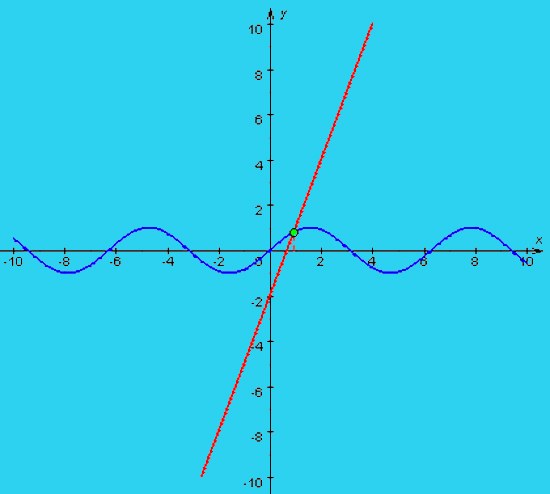Tip 1: How to find the intersection point of two graphs
Tip 1: How to find the intersection point of two graphs
Each specific schedule is specified by the corresponding function. The process of finding a point (several points) intersections two graphs reduces to solving an equation of the form f1 (x) = f2 (x), whose solution u will be the required point.

You will need
- - paper;
- - a pen.
Instructions
1
Even from the school course of mathematics, students become aware that the number of possible points intersections two graphs directly depends on the type of functions. For example, linear functions will have only one Point intersections, linear and square - two, square - two or four, etc.
2
We consider the general case with two linear functions (see Fig. 1). Let y1 = k1x + b1, and let y2 = k2x + b2. To find Point their intersections You need to solve the equation y1 = y2 or k1x + b1 = k2x + b2. Converting the equality, you get: k1x-k2x = b2-b1. Express x as follows: x = (b2-b1) / (k1-k2).
3
After finding the value of x, the coordinates of the point intersections two graphs on the abscissa axis (the 0X axis), it remains to calculate the coordinate along the ordinate axis (the 0Y axis). For this, it is necessary to substitute the value x for any of the functions. Thus, the point intersections y1 and y2 will have the following coordinates: ((b2-b1) / (k1-k2); k1 (b2-b1) / (k1-k2) + b2).
4
Analyze an example of calculating the location of a point intersections two graphs (see Fig. 2). It is necessary to find Point intersections graphs functions f1 (x) = 0.5x ^ 2 and f2 (x) = 0.6x + 1.2.Equating f1 (x) and f2 (x), get the following equality: 0.5x ^ = 0.6x + 1.2. Moving all the terms to the left side, you get a quadratic equation of the form: 0.5x ^ 2 -0.6x-1.2 = 0. The solution of this equation is two values of x: x1≈2,26, x2≈-1,06.
5
Substitute the values of x1 and x2 in any of the function expressions. For example, and f_2 (x1) = 0,6 • 2,26 + 1,2 = 2,55, f_2 (x2) = 0,6 • (-1,06) + 1,2 = 0,56. So, The required points are: tA (2.26, 2.55) and t.V (-1.06, 0.56).
Tip 2: How to find the coordinates of the intersection points of the function graph
The graph of the function y = f (x) is the set of allpoints of the plane, the coordinates x for which satisfy the relation y = f (x). The graph of the function clearly illustrates the behavior and properties of the function. To construct a graph, we usually select several values of the argument x and calculate the corresponding values of the function y = f (x) for them. For a more accurate and graphical plotting of the graph, it is useful to find its intersection points with the coordinate axes.

Instructions
1
To find the intersection point of the function graph withy axis, it is necessary to calculate the value of the function for x = 0, i.e. find f (0). For example, let's use the graph of the linear function shown in Fig. Its value at x = 0 (y = a * 0 + b) is b, therefore, the graph intersects the y-axis at the point (0, b).

2
At the intersection of the abscissa (X axis)function is 0; y = f (x) = 0. To calculate x, it is necessary to solve the equation f (x) = 0. In the case of a linear function, we obtain the equation ax + b = 0, from which we find x = -b / a. Thus, the X axis intersects at the point (-b / a, 0).
3
In more complex cases, for example, in the case ofquadratic dependence of y on x, the equation f (x) = 0 has two roots, therefore, the axis of abscissas intersects twice. In the case of a periodic dependence of y on x, for example y = sin (x), its graph has an infinite number of points of intersection with the X axis. To verify the correctness of finding the coordinates of the points of intersection of the graph of the function with the X axis, it is necessary to substitute the found values of x into the expression f (x) . The value of the expression for any of the computed x must be 0.
Tip 3: How to find the intersection points of a function
Before proceeding to the investigation of the behavior of the function, it is necessary to determine the range of variation of the quantities considered. Let us assume that the variables belong to the set of real numbers.

Instructions
1
The function is a variable dependent onthe value of the argument. The argument is a variable independent. The limits of the changes in the argument are called the range of admissible values (ODZ). The behavior of the function is considered within the boundaries of the LDU because within these limits the relationship between the two variables is not chaotic, but is subject to certain rules and can be written in the form of a mathematical expression.
2
Consider an arbitrary functional dependence F = φ (x), where φ is a mathematical expression. The function can have intersection points with coordinate axes or with other functions.
3
At the points of intersection of the function with the abscissafunction becomes zero: F (x) = 0. Solve this equation. You will get the coordinates of the points of intersection of the given function with the axis OX. Such points will be as many as there are roots of the equation on a given portion of the variation of the argument.
4
At the points of intersection of the function with the ordinate axisthe value of the argument is zero. Consequently, the problem turns into finding the value of the function for x = 0. The intersection points of the function with the OY axis will be as many as there are values of a given function with a zero argument.
5
To find the intersection points of a given functionwith another function it is necessary to solve the system of equations: Here φ (x) is an expression describing the given function F, ψ (x) is an expression describing the function W, the point of intersection with which is given functions need to be found. It is obvious that at the intersection points both functions take equal values for equal values of the arguments. The common points for the two functions will be as many as the solutions for the system of equations on a given portion of the variation of the argument.
Tip 4: How to find intersection points of functions
At the intersection points, the functions have equal values for the same value of the argument. Find the points of intersection of functions means to determine the coordinates of points common to intersecting functions.

Instructions
1
In the general form, the problem of finding the points of intersectionfunctions of one argument Y = F (x) and Y₁ = F₁ (x) in the XOY plane reduces to solving the equation Y = Y₁, since at a common point the functions have equal values. The values of x that satisfy the equality F (x) = F₁ (x), (if they exist) are the abscissas of the intersection points of the given functions.
2
If the functions are given by a simple mathematicalexpression and depend on one argument x, then the problem of finding the points of intersection can be solved graphically. Construct graphs of functions. Determine the points of intersection with the coordinate axes (x = 0, y = 0). Specify several more values of the argument, find the corresponding values of the functions, add the points obtained to the graphs. The more points will be used for construction, the more accurate the graph will be.
3
If the graphs of functions intersect, determine bythe coordinates of the points of intersection. For verification, substitute these coordinates in the formulas that define the functions. If the mathematical expressions are correct, the intersection points are found correctly. If the function graphs do not overlap, try changing the scale. Make a step between the construction points more to determine which part of the numerical plane the lines of the graph approach. Then, in the identified intersection area, construct a more detailed graph with a small step to accurately determine the coordinates of the intersection points.
4
If you want to find the intersection points of functions not onplane, and in three-dimensional space, it is necessary to consider functions of two variables: Z = F (x, y) and Z₁ = F₁ (x, y). To determine the coordinates of the points of intersection of functions, it is necessary to solve a system of equations with two unknowns x and y for Z = Z₁.







